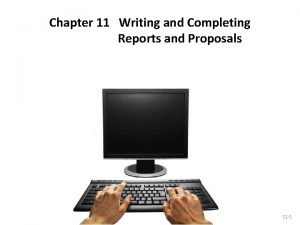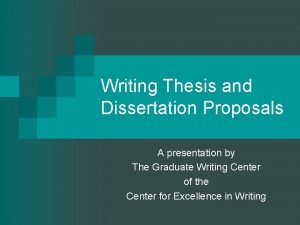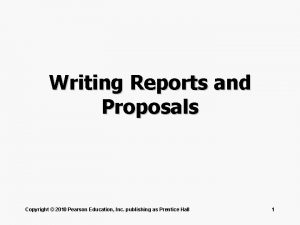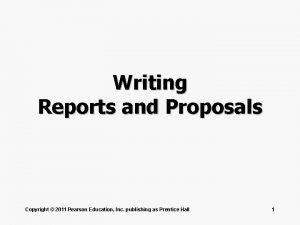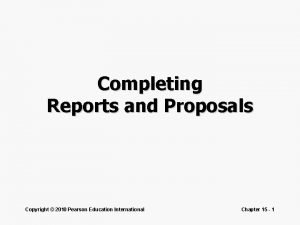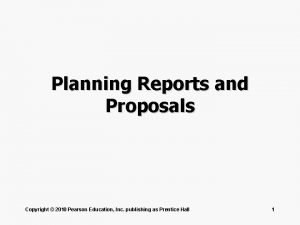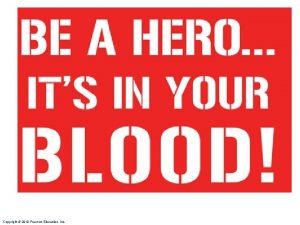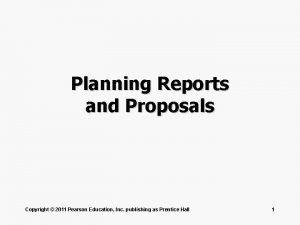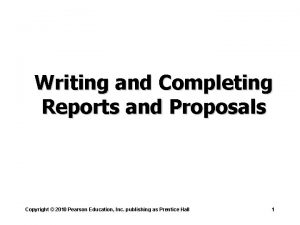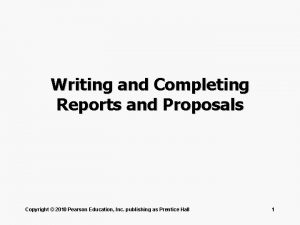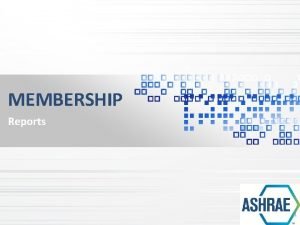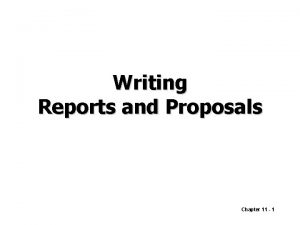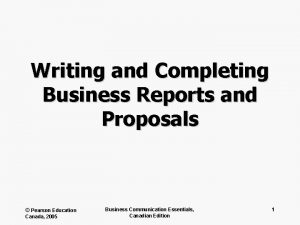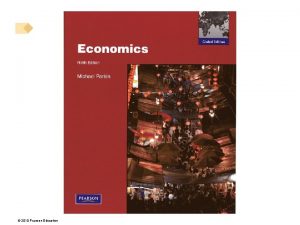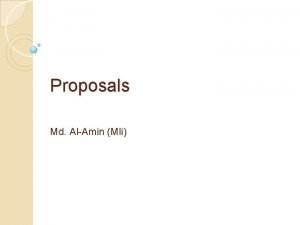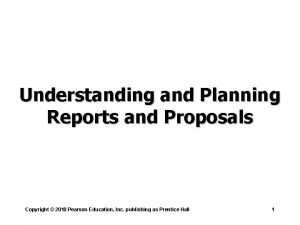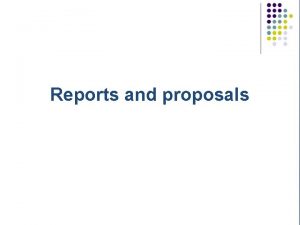Writing Reports and Proposals Copyright 2010 Pearson Education























- Slides: 23

Writing Reports and Proposals Copyright © 2010 Pearson Education International Chapter 14 - 1

Learning Objectives • Explain how to adapt to your audiences when writing reports and proposals • Name five characteristics of effective report content • List the topics commonly covered in the introduction, body, and close of formal reports Copyright © 2010 Pearson Education International Chapter 14 - 2

Learning Objectives • List six strategies to strengthen your proposal argument • Identify five characteristics of effective writing in online reports • Briefly describe three report elements that can help readers find their way in long documents Copyright © 2010 Pearson Education International Chapter 14 - 3

Reports and Proposals • Be sensitive to their needs • Build strong relationships • Control style and tone Copyright © 2010 Pearson Education International Chapter 14 - 4

Sensing Audience Needs • The “You” attitude • Sense of etiquette • Positive emphasis • Bias-free language Copyright © 2010 Pearson Education International Chapter 14 - 5

Building Relationships • Language • Content • Credibility Copyright © 2010 Pearson Education International Chapter 14 - 6

Controlling Style and Tone • Formal and informal tone – Information – Situation – Report length – Audience Copyright © 2010 Pearson Education International Chapter 14 - 7

Composing Reports and Proposals • The introduction: context, subject, purpose, main ideas, and tone • Body sections: presentation, analysis, interpretation, and support • Concluding section: benefits, main points, structure, and action items Copyright © 2010 Pearson Education International Chapter 14 - 8

Drafting Report Content • Accurate • Complete • Balanced • Clear and logical • Documented properly Copyright © 2010 Pearson Education International Chapter 14 - 9

Report Introduction Authorization Opportunity or Purpose Scope of Coverage Background Sources and Methods Terms and Definitions Limitations Report Organization Copyright © 2010 Pearson Education International Chapter 14 - 10

The Report Body • Explanations of problem or opportunity • Facts, statistics, and trends • Results of studies or investigations • Discussion and analysis of potential actions • Advantages, disadvantages, costs, and Copyright © 2010 Pearson Education International Chapter 14 - 11

The Report Body • Procedures or steps in a process • Methods and approaches • Criteria for evaluating options • Conclusions and recommendations • Support for conclusions and recommendations Copyright © 2010 Pearson Education International Chapter 14 - 12

The Report Closing • Summary • Conclusions • Recommendations • Action plans Copyright © 2010 Pearson Education International Chapter 14 - 13

Content of Proposals • The AIDA Plan – Introduction – Body – Closing Copyright © 2010 Pearson Education International Chapter 14 - 14

Strategies for Success • Demonstrate your knowledge • Provide concrete examples • Research the competition • Offer a workable proposal • Relate to needs of the audience • Package your proposal attractively Copyright © 2010 Pearson Education International Chapter 14 - 15

Proposal Introduction • Problem or background • Proposed solution • Scope or delimitations • Organization Copyright © 2010 Pearson Education International Chapter 14 - 16

The Proposal Body • Proposed solution • Work plan • Qualifications • Detailed costs Copyright © 2010 Pearson Education International Chapter 14 - 17

The Proposal Closing • Key points • Benefits and merits • Qualifications • Commitment Copyright © 2010 Pearson Education International Chapter 14 - 18

Drafting Online Content 1. Build trust with intended audiences 2. Adapt content for global audience 3. Use in a concise, skimmable format 4. Compose effective links 5. Use search engine optimization Copyright © 2010 Pearson Education International Chapter 14 - 19

Collaborating on Wikis • Forgo traditional expectations • Edit and improve each other’s work • Use templates and formatting options • Apply the appropriate tools • Practice in the “sandbox” Copyright © 2010 Pearson Education International Chapter 14 - 20

Three-Step Wiki Process • Creating a wiki • Adding content • Revising content Copyright © 2010 Pearson Education International Chapter 14 - 21

Guiding the Readers • Headings and links • Transitional devices • Previews and reviews Copyright © 2010 Pearson Education International Chapter 14 - 22

Technology for Reports and Proposals • Templates • Embedded and linked documents • Electronic forms • Electronic documents • Multimedia documents • Proposal-writing software Copyright © 2010 Pearson Education International Chapter 14 - 23
 Writing and completing reports and proposals
Writing and completing reports and proposals Prefatory elements in proposal exclude
Prefatory elements in proposal exclude 2010 pearson education inc
2010 pearson education inc Copyright 2010 pearson education inc
Copyright 2010 pearson education inc Copyright 2010 pearson education inc
Copyright 2010 pearson education inc Copyright 2010 pearson education inc
Copyright 2010 pearson education inc Copyright 2010 pearson education inc
Copyright 2010 pearson education inc Copyright 2010 pearson education inc
Copyright 2010 pearson education inc Copyright 2010 pearson education inc
Copyright 2010 pearson education inc Copyright 2010 pearson education inc
Copyright 2010 pearson education inc Composition copyright example
Composition copyright example Copyright 2010 pearson education inc
Copyright 2010 pearson education inc Business proposal chapter 10
Business proposal chapter 10 Writing thesis and dissertation proposals
Writing thesis and dissertation proposals Copyright pearson education inc
Copyright pearson education inc Copyright pearson education inc
Copyright pearson education inc Copyright 2009
Copyright 2009 2018 pearson education inc
2018 pearson education inc 2014 pearson education inc
2014 pearson education inc Copyright by pearson education inc. answers
Copyright by pearson education inc. answers 2008 pearson education inc
2008 pearson education inc Copyright 2009 pearson education inc
Copyright 2009 pearson education inc Copyright pearson education inc
Copyright pearson education inc Copyright 2009 pearson education inc
Copyright 2009 pearson education inc
